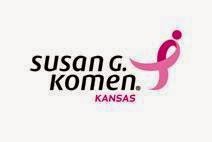In 2010, the University
of Kansas Breast Cancer Prevention Center received a $4.5 million
Promise Grant from Susan G. Komen.
This purpose of the grant is to investigate whether an estrogen found in
flax-seed – a commonly used supplement – can reduce the risk for breast cancer.
 |
| Kandy Powers, ARNP and Hayley Woods |
Hayley Woods decide to become a part of something
bigger than herself! After hearing about the research study from her local
Komen Affiliate, Hayley called the Prevention Center to see if she could
potentially qualify for the study. After an initial consultation, Hayley was
invited back to have a fine needle aspiration to collect a tissue sample. This
sample will be the final determination of whether or not Hayley will be
accepted into the trial.
Most people don’t
know what to expect when it comes to qualifying or participating for a clinical
trial. Hayley shares the experience in her own words:
“I arrived at
the Breast Research Center, and I was a little bit nervous. I was about to have
needles put in me! I was checked in right away and taken to my exam room. The
staff was all very helpful and friendly. They quickly put my mind at ease. The
nurse took my vitals and went over some paperwork with me that thoroughly
explained the procedure, the after care, and what I should expect. She also
explained a little bit more about the research study, and I was then feeling
ready and prepared.
Kandy and Amy
came in to give me an initial exam and prepare me for my fine needle
aspiration. They made casual conversation that relaxed me and made me feel
comfortable. After explaining all of the steps, they turned on some soft music
and low lights. I thought I was at the spa for a moment! They continued to
engage me in conversation that kept my mind distracted and my nerves calm.
They cleaned
the area that they would be working around, and everything was ready. The only
discomfort I experienced the entire time was a little pinch when the numbing
medication was put in. After I was numb, I felt no pain at all, from start to
finish. The procedure only took about 20 minutes, and I just rested and talked
with the ladies as they worked.
After they
were done, I applied cold packs for a few minutes before they bandaged me up.
It was over! The results will take about 4 to 6 weeks, and then I will know if
I qualify for the flaxseed trial. I would definitely do it again, and I would
recommend it to anyone interested.
I will get to
follow-up regularly with the clinic and stay on top of my breast health. This
is important to me, especially as a person without good health insurance. This
is a great opportunity to keep up on my own health and contribute to research!
It only took
about four weeks to get my aspiration results back. I was excited to find out
that I did qualify for the study! The office set me up with another appointment
to come back and finish the final steps to get me enrolled in the study.
I was asked to
fast the night before my appointment, and when I arrived, I had a blood draw.
As usual, the office staff was very friendly and helpful. I did not have to
wait long periods of time, which was important when I had my four-year old with
me!
I went over
the last details with Jessica, the study coordinator. I feel very confident
about my role in the study, which is as simple as taking my study medication
(with no known side effects) each day, and checking back in with the clinic
regularly. As I finished signing my paperwork, I found out that the study pays
me too! I had no idea! That made for a wonderful surprise, and now I’m ready to
start the study and do my part in Breast Cancer Research!”
Are you thinking
about participating in a clinical trial? Don’t hesitate! It has been a great
experience and opportunity to give back!























